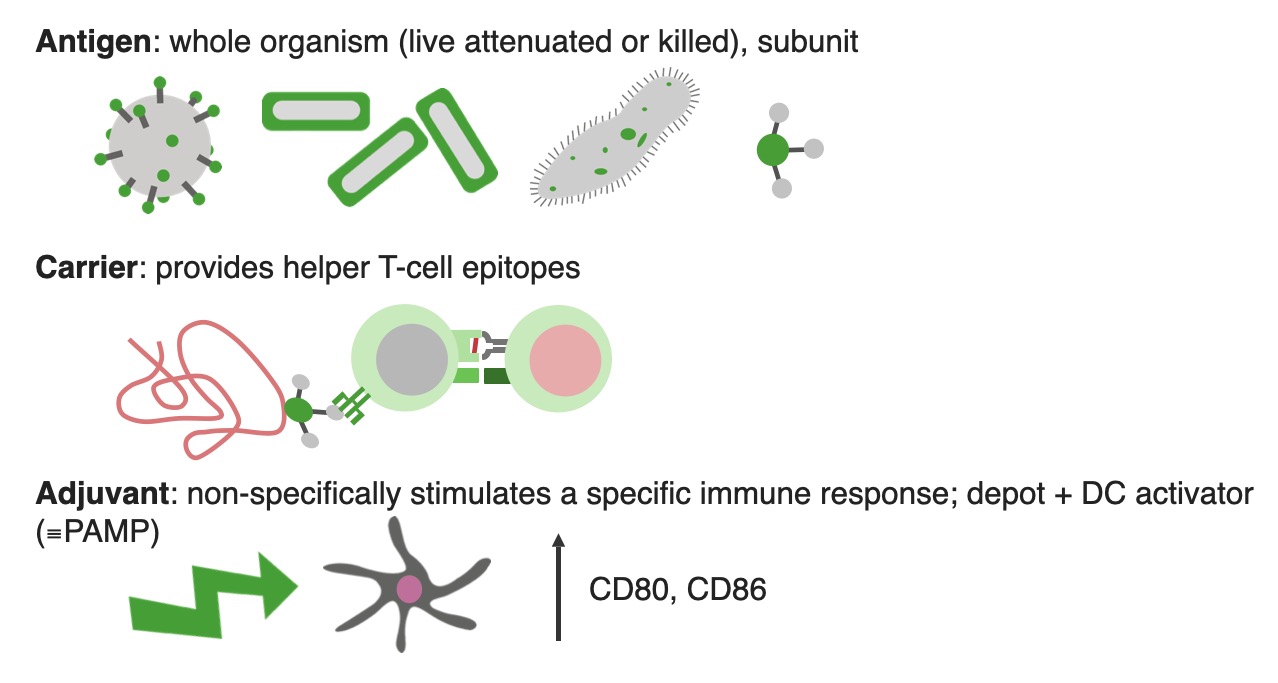Playlist
Show Playlist
Hide Playlist
Vaccine Components: Antigen, Carrier and Adjuvant
-
Slides Vaccine Immunology.pdf
-
Reference List Immune System.pdf
-
Download Lecture Overview
00:01 Let’s look now at some of the individual components that need to be present in a vaccine. 00:09 Well of course the most obvious one is the antigen. 00:11 You want to generate a antigen specific memory response. 00:16 You can use the whole organism. 00:19 Obviously you can’t use it unmodified because it would cause the pathology that the natural infection would cause, and that’s not going to be very helpful is it? But you can grow organisms so that they lose some of their pathogenicity. 00:33 We call that a live attenuated organism. 00:36 Or you can kill the organism. 00:39 Or you can take little bits of the organism, individual antigens from the organism and use those as subunit vaccines. 00:48 You often need to add a carrier, particularly with subunit vaccines because there may not be sufficient sequence to provide helper T-cell epitopes; in other words, peptides that can be shown by the MHC to the T-cell receptor on helper T-cells. So particularly with subunit vaccines, they may be coupled to a larger protein molecule as you can see here. Often one also needs to add something called an adjuvant. Now an adjuvant is a substance that non-specifically stimulates a specific immune response. And they work in a number of ways but predominantly they act as a depot so that the antigen gets released over a period of time rather than all being seen immediately. And they also activate dendritic cells, so it acts as a dendritic cell activator. And they’re equivalent really to a PAMP, to a Pathogen Associated Molecular Pattern; causing dendritic cells to up-regulate the co-stimulatory molecule CD80 and CD86. And therefore providing a really strong co-stimulation to T-cells. Examples of adjuvants include a number of aluminum salts - aluminium hydroxide, aluminium phosphate, alum which is potassium aluminium sulfate, or mixed aluminium salts. AS03 is a oil-in-water emulsion containing D-,L-alpha-tocopherol and squalene. 02:24 AS04 is aluminium hydroxide and monophosphoryl lipid A which is a low toxicity derivative of lipopolysaccharide. 02:35 And LPS stimulates toll-like receptor 4. 02:40 So it stimulates this Pattern Recognition Receptor and causes activation of dendritic cells. 02:46 MF59 is a oil-in-water emulsion of squalene. 02:50 And virosomes are double membrane lecithin-phospholipid liposomes into which viral proteins can be incorporated. 03:01 So this is just a few examples of adjuvants that have been developed. 03:06 By far the most commonly used at this time in vaccines for administration to humans are the aluminium salts. 03:15 In what situations might one want to use a vaccine? Well, clearly protection from infection and prevention of infection. 03:24 And most vaccines that are given now are aimed at preventing infection. 03:29 So an example would be the Oral Polio Vaccine. 03:34 However, there is the potential to control existing infections by vaccination. 03:41 And Zoster would be an example of that. 03:45 To prevent disease development post-exposure; as long as the rabies vaccine is given very shortly after exposure, it can prove effective. 03:58 To prevent fetal infection - Rubella is an excellent example here. 04:05 And to prevent or control cancer and the Human Papilloma virus and the Hepatitis B virus vaccines are examples of this use.
About the Lecture
The lecture Vaccine Components: Antigen, Carrier and Adjuvant by Peter Delves, PhD is from the course Vaccine Immunology. It contains the following chapters:
- A Closer Look on Vaccine Components
- Uses of Vaccines
Included Quiz Questions
ASO4 is an agonist of which of the following types of toll-like receptors?
- 4
- 1
- 2
- 3
- 5
What is the primary function of an adjuvant in some vaccines?
- Creation of a stronger immune response in those receiving the vaccine
- Moderating the immune response in those receiving the vaccine
- Reducing the risk of autism
- Preventing systemic side effects such as fever
- Preventing replication of viruses in live vaccines
Which of the following is the most commonly used adjuvant?
- Aluminum salts
- Lead
- Virosomes
- MF59
- AS03
Customer reviews
5,0 of 5 stars
| 5 Stars |
|
5 |
| 4 Stars |
|
0 |
| 3 Stars |
|
0 |
| 2 Stars |
|
0 |
| 1 Star |
|
0 |




